Technology

The function of honeycomb ceramic regenerator
In the early 1990s, Japanese scientists first invented High-Temperature Oxygen-Deficient Oxygen Combustion (HTAC) technology, which was hailed as one of the most promising technologies in the 21st century. The key of the technologies is the heat storage materials - honeycomb ceramics. Honeycomb ceramic heat storage body has the advantages of high temperature resistance, corrosion resistance, good thermal shock resistance, high strength, high heat storage capacity, good thermal conductivity, etc. The energy saving effect and service life are greatly improved. Regenerative high-temperature air combustion is a new type of technology combined with great energy-saving and environmental protection. The honeycomb ceramic regenerator is the key component of the regenerative heater. It is widely used in iron and steel, machinery, building materials, petrochemical, nonferrous metal smelting and other industries such as furnaces, hot blast stoves, heat treatment furnaces, cracking furnaces, roasters, melting furnaces, soaking furnaces, oil and gas boilers and other furnaces. This technology allows the two regenerators to absorb and release heat alternately through the commutation device to maximize the recovery of heat from the flue gas. The combustion air and gas in the furnace are then heated to temperatures above 1000°C. Even low-quality low-grade fuel can be used. It can be achieved to save up 40%-70% of fuel, increase production by more than 15%, reduce billet oxidation loss by more than 40%, achieve NOx emission of less than 100ppm, and discharge flue gas temperature below 150°C, greatly reducing The greenhouse effect of the earth's atmosphere. If most industrial kilns use HTAC technology, the economic benefits and social benefits will be inestimable, which will greatly ease the energy shortage and envied the improvement of human living environment.
Characters of High Performance Honeycomb Ceramic Regenerator
1 High-performance honeycomb regenerators are developed for the actual combustion conditions of heating furnaces , and can be adapted to the actual conditions in most heating furnaces with low control levels and poor combustion conditions.
2 The storage heat is 20-50% more than the ordinary honeycomb ceramic regenerators, so the commutation cycle is about 20-50% longer than the ordinary honeycomb ceramics, which in turn increases the service life of the reversing device and the honeycomb. For the longer service life, improve, and meet the requirements of the furnace maintenance cycle, can be synchronized with the minor repair cycle furnace.
3 Good thermal shock resistance, good thermal conductivity, high mechanical strength, better adapting to the working conditions of the regenerative heating furnace, even in the case of abnormality in the regenerative chamber due to abnormal conditions of the heating furnace ,it is also not easy to deform, collapsing slag and adhesive, and can still play the role of regenerative body;
4 Thin and smooth channel wall, low back pressure, large capacity, high heat storage, small footprint;
5 According to requirements and the different environments, we can chose different materials and specifications of the products;
6 With high quality, during installation, the regenerators are discharged neatly with a small dislocation.
How does a honeycomb heat storage burn?
In theory, a regenerative combustion system that uses a high-performance honeycomb heat storage body will make it easier to retrofit existing furnaces with higher heat recovery efficiency. If the honeycomb heat storage has a strong adaptability and a long service life, the heat exchange technology of heat storage will be widely used in industrial furnaces.
1. High refractoriness
For the regenerative combustion system, the preheating temperature of the combustion air or (and) gas is relatively more efficient. Generally, the preheating temperature is only lower than the temperature of the flue gas by 100~200°C, so the regenerator can work for a long time in high temperatures, so there is a requirement for its refractoriness. For the normal billet heating furnaces, the flue gas temperature is 1 250 ~ 1 300 °C, for high-temperature large billet heating furnaces, the flue gas temperature can reach 1 400 °C, or even higher. Therefore, There are different requirements for the refractoriness of bulk materials in the different application conditions for heat storage
2. Stable Thermal shock
According to the process of the heat exchange system, the regenerator is operated for a long time under the conditions of repeated heating and cooling, and the surface and internal temperatures are periodically changed with the time, If the thermal shock with low stability for the frequent alternating thermal expansion and contraction, the regenerator will be broken and the air flow channel will be blocked, which will increase the pressure loss and affect the heat transfer of the regenerator. That will lead to the regenerator can not work properly and be forced to replace the regenerator. According to the properties of refractories, the higher the density of the material, the greater the coefficient of thermal expansion and the worse the thermal shock stability. At the same time, the high density of materials always with large heat storage capacity. When selecting the formula for the heat storage material, we should chose the higher density.
3. Strong Structure
The regenerator is assembled with individual regenerators by layering and division. Under the actual high-temperature working conditions, the underlying regenerator needs to bear the weight of the upper layer and itself. Therefore, it is required that the regenerator must have Sufficient high temperature compressive strength and creep resistance, otherwise, will destroy the regenerator body, and increases the gas flow resistance, decreases the heat transfer efficiency, and even affect the regenerative combustion system safe operation. At the same time, under the effect of high-temperature scouring of dust gas at high temperature, the wall of the regenerator body is easily worn out and the defects are peeled off. Therefore, the regenerator body is required high hyperthermia structural strength and load softening temperature. With the experience, the long-term working temperature of refractories is generally about 100°C lower than its load softening temperature

